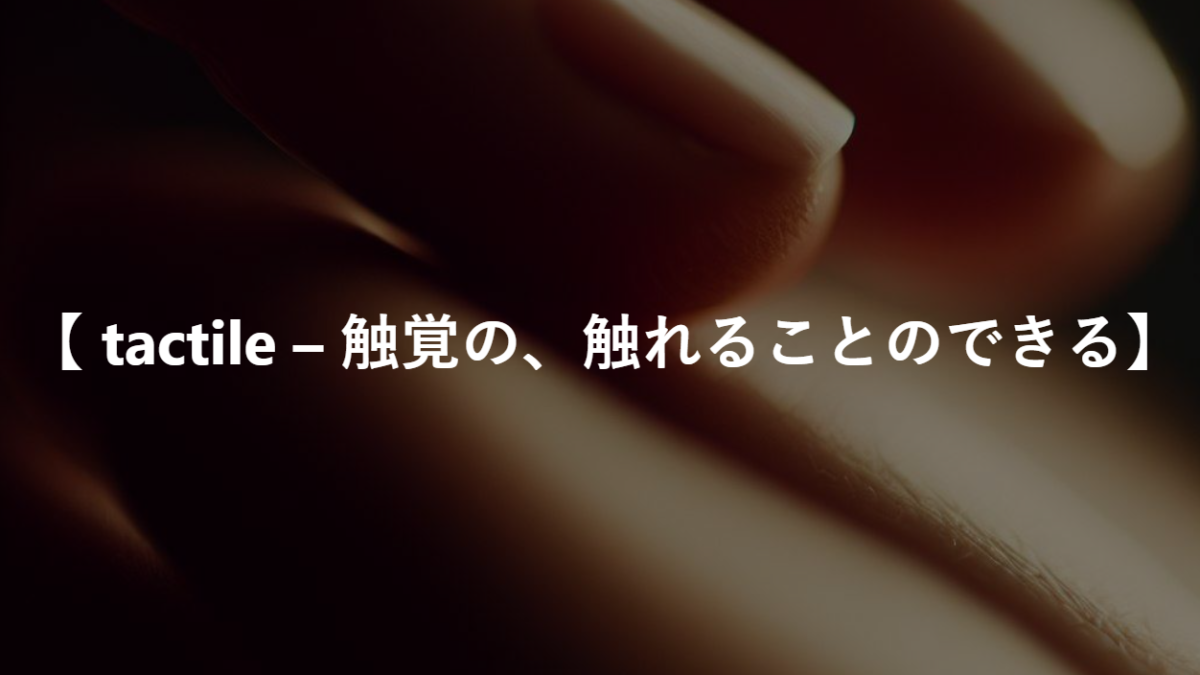語源・類義語・反対語・例文
【 tactile – 触覚の、触れることのできる】という単語の語源とか由来を知っていますか?
「Tactile」は、ラテン語の「tactilis」から来ており、「触れることができる」という意味を持ちます。これは「tangere」に由来しており、「触れる」を意味します。この言葉は、物理的な触感や触覚に関連する性質や感覚を記述するために使われるようになりました。時間が経つにつれ、「tactile」は触れることによって感じられる、または触覚によって知覚されるもの、すなわち「触覚の」や「触れることのできる」という意味で英語に取り入れられました。この単語は、触覚に関連するさまざまな文脈で使用され、触ることができる物理的な特性または触覚による体験を指すために用いられています。
The word “tactile” originates from the Latin “tactilis,” meaning “capable of being touched.” This is derived from “tangere,” which means “to touch.” Over time, “tactile” has come to describe qualities or sensations related to physical touch or the sense of touch. As it evolved, “tactile” was incorporated into the English language to denote something that can be felt through touch or perceived through the sense of touch, essentially meaning “pertaining to touch” or “touchable.” The term is used in various contexts related to the sense of touch, referring to physical characteristics that can be touched or experiences perceived through tactile sensation.
この単語の類義語・反対語を教えてください。
類義語
- Tangible – 触れることができる、具体的な。物理的に存在していて触れることが可能なものを指します。
- Palpable – 明白な、触知できる。物理的に感じられるほど明確なものを指します。
- Haptic – 触感のある。触覚に関連する、または触覚を通じて体験されるものを指します。
- Touchable – 触れることができる。物理的に接触して感じることができる特性を持つものを指します。
- Sensory – 感覚の。感覚器官を通じて得られる体験や情報に関連するものを指します。
反寧語
- Intangible – 触れることができない、非物質的な。物理的に触れることが不可能な抽象的な概念や特性を指します。
- Impalpable – 触知できない。物理的に感じることができないほど微細または抽象的なものを指します。
- Incorporeal – 無形の。物質的な実体を持たず、触れることができない状態や存在を指します。
この単語に似た単語で間違いやすい単語はありますか?
- Tangible – 「Tangible」は「実体のある」「具体的な」という意味で、「tactile」と混同されやすいですが、「tangible」は物理的な存在や具体性を強調し、触覚に限定されない広範な用途があります。
- Haptic – 「Haptic」は触覚に関連する技術や感覚を指すことが多く、特に触覚フィードバック技術などの文脈で使用されます。「Tactile」とは密接に関連していますが、技術的な応用に特化している点が異なります。
- Palpable – 「Palpable」は「明白な」「触って感じられる」という意味で、「tactile」と同様に触覚に関連しますが、感じ取れるほど明確な存在や状況を指すことが多いです。
この単語を使った例文を5つほど教えてください。
The soft, plush carpet provided a pleasant tactile experience as I walked barefoot in the room.
(柔らかくてふかふかしたカーペットは、部屋の中を裸足で歩くときに心地よい触覚の体験を提供してくれました。)
The artist created a sculpture with intricate textures, inviting viewers to explore its tactile qualities with their hands.
(アーティストは複雑なテクスチャを持つ彫刻を作り、観客に手で触れて触覚の特性を探求するように促しました。)
The tactile feedback of the keyboard allowed me to type with precision and accuracy.
(キーボードの触覚フィードバックにより、正確かつ精密にタイピングすることができました。)
The blind child explored the tactile book, running his fingers over the raised braille letters and feeling the textured illustrations.
(視覚障害のある子供は、触覚の本を探索し、指先で突起した点字の文字やテクスチャのあるイラストを感じました。)
The museum exhibit featured interactive displays that allowed visitors to have a tactile experience by touching replicas of ancient artifacts.
(博物館の展示では、訪問者が古代の遺物のレプリカに触れることで触覚の体験をすることができる対話型の展示物がありました。)
【 tactile – 触覚の、触れることのできる】のコロケーション
- tactile sensation – 触覚感覚
- 物理的な接触によって生じる感覚を指します。肌で感じるあらゆる種類の触れる感覚を表します。
- tactile experience – 触覚体験
- 触れることによって得られる経験や感覚。教育やデザイン、アートなどで、触覚を通じて情報を得る体験を指すことがあります。
- tactile feedback – 触覚フィードバック
- 技術デバイスが使用者に対して提供する物理的な反応や振動のこと。触覚を通じてユーザーに情報を伝える方法です。
- tactile interface – 触覚インターフェース
- 使用者が触れることによって操作を行うインターフェース。スマートフォンのタッチスクリーンや、特定のデバイスの表面などが例です。
- tactile learning – 触覚学習
- 触れることによって情報を得る、または技能を身につける学習方法。特に手を使って物を触りながら学ぶ手法を指します。
「Tactile」という単語は、「触覚の」や「触れることができる」という意味を持ち、主に触覚に関連する体験や特性を指します。この言葉は、触覚感覚、触覚体験、触覚フィードバック、触覚インターフェース、そして触覚学習など、さまざまなコロケーションで使用されます。これらの用法は、「tactile」がどのように使われるかを具体的に示しています。
例えば、「tactile sensation」は、肌で感じるあらゆる種類の触れる感覚を表し、物理的な接触によって生じる感覚に焦点を当てています。「Tactile experience」は、触れることによって得られる経験や感覚を指し、教育やデザイン、アートの分野で触覚を通じて情報を得る体験を示します。
技術の文脈では、「tactile feedback」はデバイスが使用者に提供する物理的な反応や振動を意味し、触覚を通じてユーザーに情報を伝える方法です。「Tactile interface」は、使用者が触れることによって操作を行うインターフェースを指し、スマートフォンのタッチスクリーンや特定のデバイスの表面がその例として挙げられます。
また、「tactile learning」は、触れることによって情報を得るまたは技能を身につける学習方法を指し、特に手を使って物を触りながら学ぶ手法に焦点を当てています。
これらのコロケーションを通じて、触覚がどのように人間の体験や情報の伝達、学習プロセスにおいて重要な役割を果たしているかが明らかになります。これらの表現は、触覚を通じて得られる体験や情報の伝達方法を理解し、正確に伝えるために不可欠です。
The term “tactile” means “pertaining to touch” or “capable of being touched,” primarily referring to experiences or characteristics related to the sense of touch. This word is utilized in various collocations such as “tactile sensation,” “tactile experience,” “tactile feedback,” “tactile interface,” and “tactile learning,” which specifically illustrate how “tactile” is employed.
For instance, “tactile sensation” refers to any kind of feeling sensed through the skin, focusing on the sensations arising from physical contact. “Tactile experience” denotes experiences or sensations gained through touching, highlighting how touch is used to acquire information in fields such as education, design, and art.
In the context of technology, “tactile feedback” means the physical responses or vibrations a device provides to its user, serving as a method to convey information through touch. “Tactile interface” refers to interfaces that are operated through physical touch, with examples including smartphone touchscreens and specific device surfaces.
Moreover, “tactile learning” points to a learning method where information is acquired or skills are developed through touch, specifically focusing on learning techniques that involve handling objects.
These collocations demonstrate the significant role tactile sensations play in human experiences, information transmission, and learning processes. These expressions are essential for understanding and accurately communicating experiences and methods of information transmission through the sense of touch.
文法問題: “tactile” (触覚の、触れることのできる)
- 品詞と使い方:
The museum exhibit featured a variety of _________ displays that encouraged visitors to touch and interact with the objects.
(A) tactility
(B) tactilely
(C) tactile
(D) tactility
解答と解説: (C) tactile 空欄には名詞 displays を修飾する形容詞が必要です。tactile は「触覚の」「触れることのできる」という意味の形容詞です。
– - 名詞形:
The _________ of the fabric was soft and luxurious against the skin.
(A) tactility
(B) tactilely
(C) tactile
(D) tactility
解答と解説: (A) tactility 空欄には主語となる名詞が必要です。tactility は「触感」「触覚性」という意味の名詞です。
– - 副詞形:
The blind woman _________ explored the sculpture with her hands, appreciating its intricate details.
(A) tactility
(B) tactilely
(C) tactile
(D) tactility
解答と解説: (B) tactilely 空欄には動詞 explored を修飾する副詞が必要です。tactilely は「触覚的に」という意味の副詞です。
– - 反意語:
The online lecture lacked the _________ engagement of an in-person classroom setting.
(A) tactile
(B) visual
(C) auditory
(D) olfactory
解答と解説: (A) tactile 文脈から、空欄には「触覚的な」の反意語が入ることがわかります。視覚、聴覚、嗅覚など、触覚以外の感覚を表す単語が適切です。ここでは、オンライン講義なので、visual (視覚の) が最も適切です。
– - 誤文訂正: The tactility nature of the massage helped to relieve the client’s muscle tension.
解答と解説: tactility → tactile 空欄には名詞 nature を修飾する形容詞が必要です。tactility は名詞なので、形容詞 tactile に修正する必要があります。

